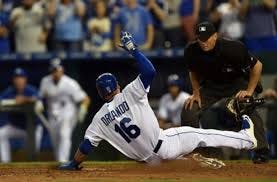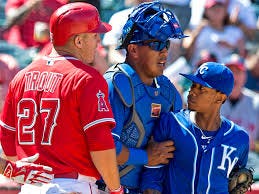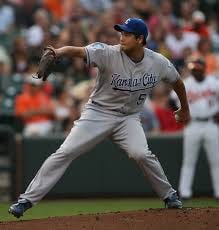April 10th, 2015—Angels
The Royals are playing the Angels and three more Kansas City batters get hit by pitches; two of them are Mike Moustakas.
People are starting to notice just how often Kansas City batters are getting drilled by opposing pitchers and I’m asked about it. I don’t know for sure, but I can make a pretty good guess about what’s happening with Moose: pitchers are trying to pitch him inside and missing.
Last year Moose was pulling the ball into the defensive shifts on the right side of the field, this year he’s willing to take outside pitches the other way; he’s not an easy out right now. Opposing pitchers want Mike to go back to pulling the ball.
In 2015 Moustakas appears to have a plan at the plate and the pitchers want him to come off that plan, so they’re pitching him inside to force him to pull the ball and sometimes they’re pitching him too far inside and hitting him, which, just in case you were wondering, hurts like a motherfucker.
The Royals beat the Angels 4-2 and Wade Davis gets his first save of the season. Wade is then asked to do the postgame, on-field interview. The player who does this interview usually gets a bucket of ice water poured over his head, but none of Wade’s teammates have the guts—or stupidity—to dump ice water on him.
Apparently Wade Davis intimidates the other Royals as much as he intimidates opposing hitters.
Wade Davis—2013
When James Shields and Wade Davis come over to Kansas City from Tampa Bay, I’m told I’ll love Shields—he’s a talker—and won’t get two words out of Davis. Big Game James and I never click, but the first time I talk to Wade, we have a 20-minute conversation.
Wade’s a very smart pitcher and lucky for me he likes talking baseball.
Wade scuffles as a starter, but is eventually sent to the Royals bullpen and that’s when things take off for him. In 2013 as a starting pitcher, Wade has an ERA of 5.32. Pitching out of the bullpen in 2014, Wade’s ERA drops to 1.00.
There’s a logical explanation: when a pitcher is starting, he has to pace himself to throw around 100 pitches and face the opposing lineup three times—when that same guy goes to the bullpen he can give it everything he’s got right away. Relief pitchers also don’t need to throw as many types of pitches; they’re only going to see a hitter once, so a fastball, cutter and curve might be plenty—they don’t ever have to throw their fourth or fifth-best pitch.
Some guys are good at running marathons; other guys are built to sprint.
This is why relief pitchers often get used one inning at a time; they’re good because they know they’re pitching just one inning and can empty the tank. Start using those pitchers for multiple innings – “Hey, he pitched great in the seventh, let’s send him back out for the eighth” – and they might start pacing themselves and their stuff drops off.
Wade Davis as a starter is so-so, but Wade Davis out of the bullpen is a beast.
Paulo Orlando—2015
“Early work” is called that because it happens early in the day before batting practice. It’s a chance for coaches to work with a player or group of players on some part of their game. And it’s a chance for me to learn something about baseball.
Today, base-running coach Rusty Kuntz is working with outfielder Paulo Orlando.
They’re working on Paulo’s lead at first base and Rusty’s pointing at Paulo’s right foot. After they finish, I ask Rusty about it and that’s when I get my base stealing lesson.
The first move a base stealer makes is a crossover step toward second base; the left foot crosses over the right and that turns the runner’s body toward second.
Rusty has me stand like I’m a base runner and point both feet toward home plate. He then asks me to take a crossover step with my left foot and see how big a step I can take: I can barely get my left foot past my right.
Then Rusty asks me to turn my right foot at a 45-degree angle toward the pitcher’s mound and try another crossover step. Turning my right foot 45 degrees opens my hips and allows my left foot to make a much longer stride toward second base. When things are being measured in fractions of seconds, that longer stride might be the difference between being out or safe.
This boring attention to detail can lead to exciting results: a stolen base with the game on the line.
Some fans seem to enjoy the idea that ballplayers, coaches, managers and general managers are complete morons.
It might be fun to think that you’re smarter than the people who play, coach and manage the game, but it’s probably not true and if the subject is baseball it’s definitely not true.
One of the most arrogant conclusions in Moneyball—and there were plenty to choose from—was that any reasonably smart guy could run a baseball team; no experience necessary.
Full disclosure: there are guys in the big leagues thick as a two planks, but those guys are usually incredibly gifted athletes; they couldn’t survive otherwise. And they don’t make those guys coaches.
Spend time talking baseball with Rusty Kuntz or Mike Jirschele or Dave Eiland and the idea that these coaches are tobacco-chewing dinosaurs goes out the window; that’s an inaccurate stereotype promoted by people who don’t know them or spend time around baseball teams.
And to assume a guy stole a base simply because he’s fast is to ignore all the attention to detail and hard work necessary to make that happen.
April 12th, 2015—Angels
After losing 9-2 to the Royals, Angels starting pitcher C.J. Wilson talks about how aggressive the Royals hitters are early in the count. Like every other pitcher in the history of pitching Wilson wants to pitch in two strike counts because then he can throw chase pitches: pitches thrown out of the strike zone in hopes that the hitters will chase them.
But because the Royals are so aggressive, Wilson can’t get ahead; he throws 94 pitches and faces 29 batters, but only gets ahead 0-2 three times and 1-2 four times.
The Royals are hacking early and often.
If I’d been smarter, I would have understood what the Royals were doing, but like a lot of other people I miss the point. Early in 2015 I still believe good teams get starting pitchers out of the game by being patient and taking pitches. It’s boring, but effective: work the starter’s pitch count up, force him out of the game early and then go to work against the other team’s middle relievers, the weakest part of any pitching staff.
It might take three-and-a-half-hours, but a win’s a win.
But the 2015 Royals have a different approach: instead of showing patience and taking pitches, Royals hitters are attacking early in the count.
Pitchers often throw fastballs to get ahead in the count and then go to their off-speed stuff to put hitters away. But the Royals aren’t letting the pitchers get ahead; they’re going after those early fastballs and avoiding two-strike counts. It’s why the Royals are the hardest team in the league to strike out and the hardest team to walk.
Kansas City hitters aren’t at the plate long enough to do either one.
Along with a lot of other people I make the mistake of thinking the Royals are showing a lack of patience, but if you were still complaining about the fact that the Royals didn’t walk much (and a whole bunch of people were) you (and I) didn’t understand their strategy.
And now back to…
April 12th, 2015—Angels
The media has been describing pitcher Yordano Ventura as “unflappable” or “composed” or “difficult to rattle,” but those descriptions are wildly inaccurate and in the final game of the Angels series we see some of the emotions beneath the surface.
Mike Trout hits a single and Ventura stares Trout down. Trout doesn’t understand why Ventura is glaring at him and yells something at Yordano.
Next, Albert Pujols doubles and after coming all the way around to score, Trout says something to Ventura, who’s backing up home plate. Trout claims whatever he said was directed at a teammate; Ventura doesn’t agree.
Before things get out of hand, catcher Salvador Perez steps in and drags Ventura away, which is smart of Salvy. You don’t want your No. 1 pitcher getting in a fight with a guy two inches taller and 40 pounds heavier. (I got those numbers off Baseball Reference, but that picture makes their difference in size look even more dramatic; Salvador Perez looks like he’s stopping a Chihuahua from fighting a pit bull.)
Back in January I’d written a piece questioning whether Yordano Ventura was emotionally equipped to handle the pressure of being the Opening Day starter. I’d heard behind-the-scenes stories that contradicted Ventura’s cool/calm image and wondered whether he would be better off pitching further down in the rotation where there wouldn’t be so much pressure.
Some guys can channel emotion into better performances, most guys can’t: they lose focus. Sunday’s altercation isn’t much—a couple guys yapping at each other—so maybe it’s not an issue, but it’s something the Royals need to keep an eye on.
Bruce Chen—2012
There’s a lot of pressure on the #1 pitcher in a team’s rotation and Bruce Chen’s ability to stay calm is why he got the Opening Day start in 2012. As Jason Kendall said at the time; you can pitch Bruce anywhere in the rotation and he’s going to wind up 11 and 11 with a 4.50 ERA.
In 2012 Bruce Chen is mentally prepared to handle the burden of being the No. 1 starter; in 2015 it appears Yordano Ventura still has some things to learn.
BTW: In 2012 Bruce goes 11-14 with a 5.07 ERA—Kendall wasn’t that far off.
Bruce Chen—2011
Baseball downplays it, but in 2011 a lot of ballplayers still chew tobacco. There’s usually a large baggy of the long-leaf variety somewhere on the Royals bench and players go by and grab some when they need it; having a communal bag means players aren’t scuffling around trying to find chew between innings. But that communal bag of tobacco gives someone a golden opportunity for a practical joke.
In the middle of a game, someone informs Ned Yost his teeth are green, Ned responds, “Hey, your teeth are green, too.”
Someone put green food dye in the tobacco and the main suspect is Bruce Chen. When Bruce is accused of putting dye in the tobacco his look of hurt innocence is comical—as well as highly unbelievable.
I never hear if the culprit is discovered, but if Bruce didn’t do it I’m guessing he got away with something else, so he might as well wear this one.
Alex Gordon—2011
One day in 2011 I ask Jeff Francoeur how long it will take me to puke if I try chewing tobacco; Frenchy says five minutes.
So the next day a group of ballplayers gathers in the dugout to watch me try chewing tobacco for the first time. We discuss the dubious merits of long-leaf tobacco versus dip—the ground up tobacco you tuck inside your lower lip—and Mike Aviles urges me to: “Go for the Thunder.”
(Apparently, dip tobacco is much stronger.)
I say let’s do this and out of the blue Alex Gordon offers to hold the stopwatch. I don’t know Alex all that well, but we sit and talk as the players wait for me to vomit.
This is participatory journalism at its finest.
Gordon’s a quiet guy and when he hit .215 in 2010 that quiet demeanor was mistaken for arrogance or not caring; Alex did not throw bats or helmets or beat up water coolers when he struck out (at least publicly) so a lot of fans assume that means Alex just doesn’t care—nothing could be further from the truth.
When Alex hit .303 in 2011 that same quiet demeanor is held up as an example of professionalism. Alex Gordon hadn’t changed one bit, but because his results improved his public image improved.
Later I find out that Alex isn’t always so quiet.
I notice the metal door to the indoor batting cage has numerous dents and dings and realize this is where players come to break a bat or kick a door; doing it in the dugout where fans can see a player’s tantrum is considered unprofessional. I ask Alex about it, he smiles and says he’s good for at least one broken bat a year.
As I discover that afternoon while he holds a stopwatch on me, Alex Gordon is a very very nice guy—even if he does want to see me puke.
I don’t.
But it’s close.
Tomorrow: The Royals have a confrontation with the Oakland A’s.










Never thought these words would come off this idiot's keyboard, but congratulations for not puking.
PS - with Uncle Rusty's incredible patience and attention to detail, could he be refocused on the Royals offense? If not that, then the U.S. Economy?